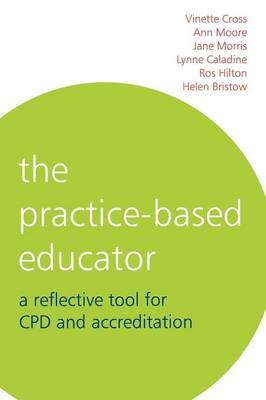
The Practice-Based Educator
John Wiley & Sons Inc (Verlag)
978-1-86156-422-1 (ISBN)
The authors are all educators of experience who have for many years been involved in practice-based education
Fully updated to cover current trends such as the move to community-based practice and inter-professional practice
Practical features include activities, reflective assignments and literature references
Ann P Moore, University of Brighton, UK, Lynne Caladine, Clinical Research Centre, UK, Jane Morris, Clinical Research Centre, UK, Ros Hilton, King's College, UK, Vinette Cross, University of Birmingham, UK and Helen Bristow
Contributors. Foreword.
Preface.
Acknowledgments.
1. About This Book and How to Use It.
Introduction.
Who will find this book useful.
What does the book aim to do?.
Learning outcomes.
What is reflection and what does it offer the practice-based educator?.
How is reflective thinking organised?.
How can reflection help to make sense of experience?.
How does the book use reflection to help develop your role?.
How can the book help to provide evidence for CPD?.
Summary.
References and further reading.
2. Practice-Based Learning and Healthcare Quality.
Introduction.
Learning outcomes.
What is practice-based learning?.
Practice-based educators.
The scope of the practice-based educator's role.
Current issues influencing practice-based education.
Accreditation of practice-based educators.
Summary.
References and further reading.
3. Multiple Roles of the Practice-Based Educator.
Introduction.
Learning outcomes.
What is the role of the practice-based educator?.
The practice-based educator as a facilitator of learning.
The practice-based educator as an assessor.
The practice-based educator as an evaluator.
Rewards for the practice-based educator.
The learner's perspective.
The importance of self-awareness.
Summary.
References and further reading.
4. Practice-Based Learning Environment: Social Context and Relationships.
Introduction.
Learning outcomes.
The learning environment.
Physical influences on the learning environment.
Psychosocial influences on the learning environment.
Cultural influence on the learning environment.
Summary.
References and further reading.
5. Learning Theories.
Introduction.
Learning outcomes.
Why bother with learning theories?.
Adults as learners.
Stages of learner development.
Adult learning and other approaches to learning theory.
Types of learning.
Control of the learning process.
Learning styles.
Transfer of learning.
Levels of processing.
Learning intention.
Summary.
References and further reading.
6. Facilitating Learning in the Practice Setting.
Introduction.
Learning outcomes.
What do we mean by facilitation?.
What do we want to facilitate?.
Principles for effective facilitation of effective learning.
Stages of practice-based learning and facilitation.
THE FACILITATION TOOLKIT.
Section One: Structuring learning.
Negotiating learning agreements.
Diagnosing readiness to learn.
Using demonstration to facilitate learning.
Providing opportunities for structured observation.
Questioning and discussion.
Giving feedback.
Section Two: Fostering collaboration.
Peer assisted learning.
Inter-professional learning and peer development.
Problem-based learning.
Section Three: Promoting empowerment.
Challenge and support.
Cognitive dissonance.
Learning relationships.
Portfolio development.
Section Four: Troubleshooting.
Learner alienation in the practice-based learning environment.
Match and mismatch between learner development and educator approach.
Fear and failure.
Enhancing communication and dialogue.
The blocked learning cycle.
Summary.
References and further reading.
7. Assessing Practice-Based Learning
Introduction.
Learning outcomes.
What is assessment.
Why do we assess?.
When do we assess?.
Who is involved in assessment.
How do we assess?.
Summary.
References.
8. Evaluating the Practice-Based Learning Experience.
Introduction.
Learning outcomes.
What is evaluation and how does it differ from assessment?.
What does evaluation involve?.
Evaluation and reflection.
The overlapping cycle of reflection.
Developing an evaluation strategy.
Why do we want to evaluate?.
What aspects of the learning experience do we want to evaluate?.
Choosing a methodology.
When does evaluation occur?.
Who is involved in evaluation?.
How will evaluation information be disseminated and used?.
Summary.
References and further reading.
9. Putting It All Together: Developing a Practice-Based Learning Curriculum.
Introduction.
Learning outcomes.
Developing a practice-based curriculum.
Influences and constraints on the learning experience.
Planning the learning process.
Designing learning experiences and opportunities.
Managing the learning process.
Assessing learning outcomes.
Evaluating the overall learning experience.
Reflecting on the learning process and planning change.
Summary.
Further reading.
Appendix 1: Practice Placement assessment Form.
Appendix 2: Practice Placement Evaluation Form.
Glossary.
Index.
| Erscheint lt. Verlag | 14.7.2006 |
|---|---|
| Verlagsort | New York |
| Sprache | englisch |
| Maße | 154 x 228 mm |
| Gewicht | 425 g |
| Themenwelt | Medizin / Pharmazie |
| Sozialwissenschaften ► Pädagogik | |
| ISBN-10 | 1-86156-422-8 / 1861564228 |
| ISBN-13 | 978-1-86156-422-1 / 9781861564221 |
| Zustand | Neuware |
| Haben Sie eine Frage zum Produkt? |
aus dem Bereich


